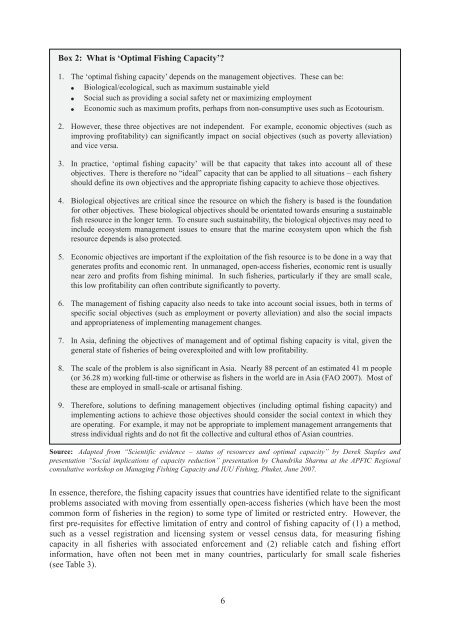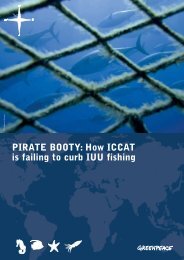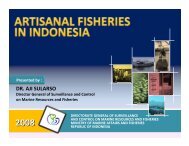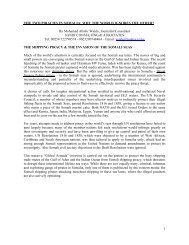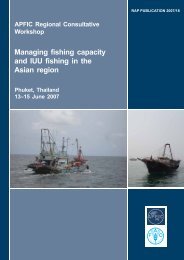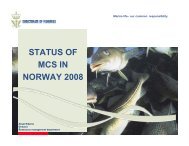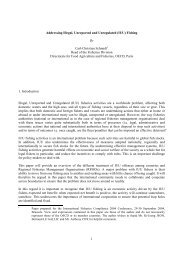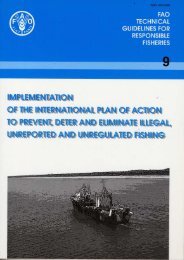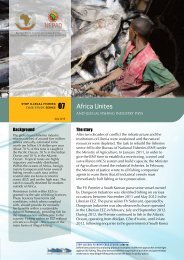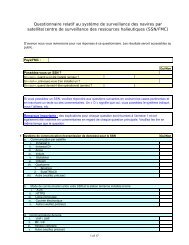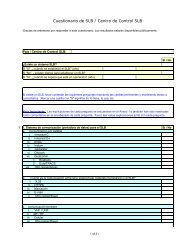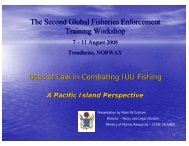Fishing capacity management and IUU fishing in Asia - FAO.org
Fishing capacity management and IUU fishing in Asia - FAO.org
Fishing capacity management and IUU fishing in Asia - FAO.org
Create successful ePaper yourself
Turn your PDF publications into a flip-book with our unique Google optimized e-Paper software.
Box 2: What is ‘Optimal <strong>Fish<strong>in</strong>g</strong> Capacity’?1. The ‘optimal <strong>fish<strong>in</strong>g</strong> <strong>capacity</strong>’ depends on the <strong>management</strong> objectives. These can be:● Biological/ecological, such as maximum susta<strong>in</strong>able yield● Social such as provid<strong>in</strong>g a social safety net or maximiz<strong>in</strong>g employment● Economic such as maximum profits, perhaps from non-consumptive uses such as Ecotourism.2. However, these three objectives are not <strong>in</strong>dependent. For example, economic objectives (such asimprov<strong>in</strong>g profitability) can significantly impact on social objectives (such as poverty alleviation)<strong>and</strong> vice versa.3. In practice, ‘optimal <strong>fish<strong>in</strong>g</strong> <strong>capacity</strong>’ will be that <strong>capacity</strong> that takes <strong>in</strong>to account all of theseobjectives. There is therefore no “ideal” <strong>capacity</strong> that can be applied to all situations – each fisheryshould def<strong>in</strong>e its own objectives <strong>and</strong> the appropriate <strong>fish<strong>in</strong>g</strong> <strong>capacity</strong> to achieve those objectives.4. Biological objectives are critical s<strong>in</strong>ce the resource on which the fishery is based is the foundationfor other objectives. These biological objectives should be orientated towards ensur<strong>in</strong>g a susta<strong>in</strong>ablefish resource <strong>in</strong> the longer term. To ensure such susta<strong>in</strong>ability, the biological objectives may need to<strong>in</strong>clude ecosystem <strong>management</strong> issues to ensure that the mar<strong>in</strong>e ecosystem upon which the fishresource depends is also protected.5. Economic objectives are important if the exploitation of the fish resource is to be done <strong>in</strong> a way thatgenerates profits <strong>and</strong> economic rent. In unmanaged, open-access fisheries, economic rent is usuallynear zero <strong>and</strong> profits from <strong>fish<strong>in</strong>g</strong> m<strong>in</strong>imal. In such fisheries, particularly if they are small scale,this low profitability can often contribute significantly to poverty.6. The <strong>management</strong> of <strong>fish<strong>in</strong>g</strong> <strong>capacity</strong> also needs to take <strong>in</strong>to account social issues, both <strong>in</strong> terms ofspecific social objectives (such as employment or poverty alleviation) <strong>and</strong> also the social impacts<strong>and</strong> appropriateness of implement<strong>in</strong>g <strong>management</strong> changes.7. In <strong>Asia</strong>, def<strong>in</strong><strong>in</strong>g the objectives of <strong>management</strong> <strong>and</strong> of optimal <strong>fish<strong>in</strong>g</strong> <strong>capacity</strong> is vital, given thegeneral state of fisheries of be<strong>in</strong>g overexploited <strong>and</strong> with low profitability.8. The scale of the problem is also significant <strong>in</strong> <strong>Asia</strong>. Nearly 88 percent of an estimated 41 m people(or 36.28 m) work<strong>in</strong>g full-time or otherwise as fishers <strong>in</strong> the world are <strong>in</strong> <strong>Asia</strong> (<strong>FAO</strong> 2007). Most ofthese are employed <strong>in</strong> small-scale or artisanal <strong>fish<strong>in</strong>g</strong>.9. Therefore, solutions to def<strong>in</strong><strong>in</strong>g <strong>management</strong> objectives (<strong>in</strong>clud<strong>in</strong>g optimal <strong>fish<strong>in</strong>g</strong> <strong>capacity</strong>) <strong>and</strong>implement<strong>in</strong>g actions to achieve those objectives should consider the social context <strong>in</strong> which theyare operat<strong>in</strong>g. For example, it may not be appropriate to implement <strong>management</strong> arrangements thatstress <strong>in</strong>dividual rights <strong>and</strong> do not fit the collective <strong>and</strong> cultural ethos of <strong>Asia</strong>n countries.Source: Adapted from “Scientific evidence – status of resources <strong>and</strong> optimal <strong>capacity</strong>” by Derek Staples <strong>and</strong>presentation “Social implications of <strong>capacity</strong> reduction” presentation by Ch<strong>and</strong>rika Sharma at the APFIC Regionalconsultative workshop on Manag<strong>in</strong>g <strong>Fish<strong>in</strong>g</strong> Capacity <strong>and</strong> <strong>IUU</strong> <strong>Fish<strong>in</strong>g</strong>, Phuket, June 2007.In essence, therefore, the <strong>fish<strong>in</strong>g</strong> <strong>capacity</strong> issues that countries have identified relate to the significantproblems associated with mov<strong>in</strong>g from essentially open-access fisheries (which have been the mostcommon form of fisheries <strong>in</strong> the region) to some type of limited or restricted entry. However, thefirst pre-requisites for effective limitation of entry <strong>and</strong> control of <strong>fish<strong>in</strong>g</strong> <strong>capacity</strong> of (1) a method,such as a vessel registration <strong>and</strong> licens<strong>in</strong>g system or vessel census data, for measur<strong>in</strong>g <strong>fish<strong>in</strong>g</strong><strong>capacity</strong> <strong>in</strong> all fisheries with associated enforcement <strong>and</strong> (2) reliable catch <strong>and</strong> <strong>fish<strong>in</strong>g</strong> effort<strong>in</strong>formation, have often not been met <strong>in</strong> many countries, particularly for small scale fisheries(see Table 3).6


